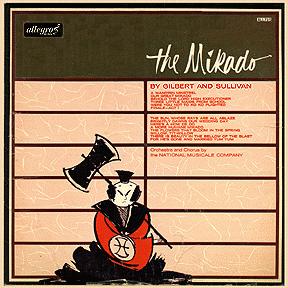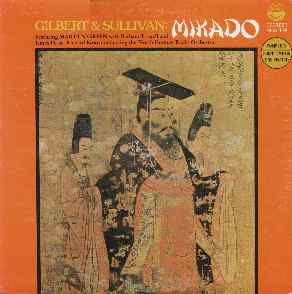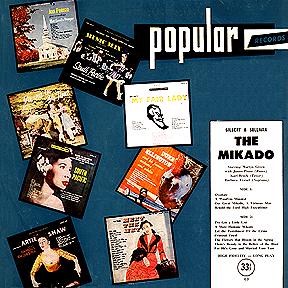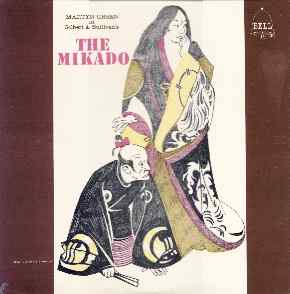The Allegro-Royale Mikado (1954)
Nord-West Deutsche Rundfunk Chorus
London Savoyard Orchestra and Chorus |
|
Shortly after he left D'Oyly Carte, Martyn Green made another recording of The Mikado, his third, on a rival label. Copyright laws of the time permitted such recordings, even though D'Oyly Carte still controlled the stage performing rights.
The circumstances of the recording are fuzzy, but it appears that the three "stars" (Green, James Pease, and Karl Brock) recorded their parts in either England or America, while the orchestra, chorus, and remaining principals recorded their parts in Germany. There's no question that most of the singers are German, and odd differences in the recording levels suggest that not all parts were recorded at the same time.
As Robert Angus related:
Music Collection International ETDCD 138A few years later [after it was made], I found myself working for Eli Oberstein, the impresario of Royale and the creator of this particular album. It seems that Eli recorded the vocalists (in New York, I think), with a piano playing the accompaniment very softly in the background. Then that tape was flown to Hamburg, where producer Paul Lazare fed it through earphones to the conductor (Richard Korn), who was responsible for keeping the orchestra tempo in sync with the already-recorded singers. Lazare had formed a house orchestra (the Hamburg Philharmonia on some occasions) consisting mainly of musicians from the Hamburg Opera and the radio and symphony orchestras. Their work consisted mainly of standard classics, which were sold to such labels as MGM, Royale and RCA Camden, but Lazare would also record specific works for a regular client (such as the music of American composers recorded for MGM) and specialty items like Oberstein's Mikado. Oberstein was using the same technique to record albums of operatic arias by the likes of Giovanni Martinelli, Lawrence Tibbett and James McCracken. In the latter case, something went wrong and the orchestra was a full half-tone higher than the singer. The technique of multitracking was still a good ten years away when Oberstein and Lazare came up with this arrangement. Multitracking generally involves laying down the instrumental tracks first and putting the vocals on top of them, the exact opposite of what was done in The Mikado.
Review by Tony Parkes
This is a Mikado that Martyn Green recorded shortly after he left D'Oyly Carte in 1951. The liner notes have a 1954 copyright but refer to Green's memoirs (1952) and the G&S movie (1953) as still in progress. My copy is Allegro-Royale 1574-1575 (two LPs); a 1960 Schwann catalogue lists the same recording as Rondolette 22.
 Society SOC-989 |
 Everest 3412 |
 Popular Records C3 |
This set is awful: worse than the Phase-4 Pinafore, worse (if you can imagine it) than Green's 1966 Pirates on RCA. The album cover sets the tone, with photos of Green and conductor Richard Korn looking like restaurant captains confronting a tramp. Korn directs "The Philharmonic Orchestra" (who had the good sense not to give their right names) and the North West German Radio (NWDR) Chorus.
James Pease is by far the best of the soloists: so good, in fact, that he was asked to double the Mikado and Pooh-Bah. He alone combines a good singing voice with a sense of characterization and even appears to be enjoying himself. It also helps that he's English; apart from Green and American tenor Karl Brock, all the others display Germanic accents ranging from strong to impenetrable.
Green gives the worst Ko-Ko performance of his recording career, exuding a "let's get this over with" attitude. Brock sings through his nose and much too close to the microphone; [His American accent is also extremely irritating. —ed.] James Stockmann (Pish-Tush) sings through clenched teeth. Barbara Troxell (Yum-Yum) wobbles on the high notes, and Ursula Boese (Katisha) has a passable voice but no grasp of the required changes of mood. Peep-Bo and Pitti-Sing are, mercifully, uncredited.
But the real villians of the piece are the arranger and the sound engineer. The orchestration is atrocious and appears to have been made from a vocal score. [Doubtless, D'Oyly Carte would have been unwilling to rent or loan scores to a company seeking to make a competing recording. —ed.] Countless passages are played by the wrong group of instruments or in the wrong octave; traditional humorous effects are absent, and added effects abound; staccatos and dynamics are disregarded; extraneous piccolos, brass and drums are everywhere.
The soloists are closely miked, and the chorus is all but inaudible. The acoustic occasionally changes abruptly in the middle of a number. [It turns out that Green, Pease and Brock were dubbed in England, while the orchestra, chorus and remaining soloists were recorded in Germany. —ed.]
The miracle is that The Mikado is such a masterpiece that some of its spirit shines through the dreary presentation. Some, but not enough. I've never been able to take it all in one sitting.
The Re-Issues
Despite the awful performances, this recording enjoyed numerous re-issues throughout the 1960s and '70s. The 1965 re-issue on the "Society" label lists a different conductor, Nigel Lucas, and a new orchestra, the London Savoyard Orchestra. However, it is essentially the same recording, but with some interesting differences, described by J. Donald Smith:
There is a new overture — very different, and with the sound one normally associates with Mantovani and his 101 strings, as well as some very strong winds and organ. Perhaps the new orchestral interludes justified the new conductor and orchestra. The numbers (in order):
- Overture
- "A wandering minstrel"
- "Our great Mikado"
- "Behold the Lord High Executioner"
- "Taken from the county jail"
- Musical Interlude — other version of the overture
- "I've got a little list"
- "A more humane Mikado"
- "The criminal cried"
- "The flowers that bloom in the spring"
- "Tit-willow"
- "There is beauty in the bellow of the blast"
- Finale
- Another orchestral filler.
Smith also adds that the Pitti-Sing (not credited on the album sleeve) sounds like the same singer as Katisha. His final comment: "I doubt that I will ever want to listen to any version [of this recording] again."
The late 1950s highlights disc on Rondolette, reissued in 1961 on Bell, includes the overture, "A wandering minstrel," "Our great Mikado," "Virtuous man" [sic; listed as a separate item, but in fact a typo], "Behold the Lord High Executioner," "I've got a little list," "A more humane Mikado," "Let the punishment fit the crime" [sic], "The crimial cried," "Flowers that bloom in the spring," "Willow, titwillow," "There's beauty in the bellow of the blast," and "For he's gone and married Yum-Yum."
The album cover for the Bell re-issue is shown at the top of this page. I don't have a screenshot for the Rondolette version, but it appears to be similar to the later Rondo version, pictured below right, which Mike Tunney described it as follows:
Rondo ST586 (partial scan)Your page does not give a description of the cover, which is one of the least appropriate (also ugliest) covers ever produced. It is a color photograph of three "oriental" dancing girls in reddish-purple two piece costumes with bare midriffs, their arms up in the air. (Three little maids?) Kneeling before them, their hands clasped above their heads in a gesture of supplication, are two young men, naked from the waist up, wearing red turbans and arm bands.
On the back is a photo of Green looking like a lounge lizard with a tiny black mustache. There are liner notes mostly of Green with a word or two about the principal singers. Nothing is mentioned of the chorus or orchestra or where or when it was recorded — only "A product of the Rondo Record Corporation, Union City, NJ.
Mike found it in a thrift score for fifty cents, and he opined that it is "undoubtedly the worst recording of anything ever made." I replied that Mike had paid $0.49½ too much.
| Date | Label | Format | Number | Comments |
|---|---|---|---|---|
| 1954 | Allegro-Royale | Mono LP | 15774/75 | |
| 1954 | Royale | 10" Mono LP | 1882 | Highlights. Performers given only as "The Savoyards". |
| 1956 | Allegro | Mono LP | 1681 | According to Bob Lang, the cover pictures "a b/w portrait of Green holding the ugliest red fan I've ever seen." |
| Late 1950s | Rondolette | Mono LP | A22 | Highlights. Also issued as Rondo ST586, date unknown. |
| 1950s/60s | Popular Records | Mono LP | C3 | |
| 1961 | Bell | Mono LP | 31 | |
| 1965 | Society | Mono/Stereo LP | SOC 989 | Highlights only; with a new overture and orchestral interludes in stereo |
| 1971 | HI-LIFE | Stereo LP | HLS 31 | According to the liner notes, HI-LIFE is (was) a division of Bell records |
| 1971 | Boulevard | Stereo LP | 4041 | Same as the Society re-issue, above, but with the 1950s bits in reprocessed stereo |
| 1977 | Everest | Mono LP | 3412 | Complete on one LP/cassette |
| Cassette | 3412 | |||
| 1999 | Music Collection International | CD | ETDCD 138 |



